Desert Flower
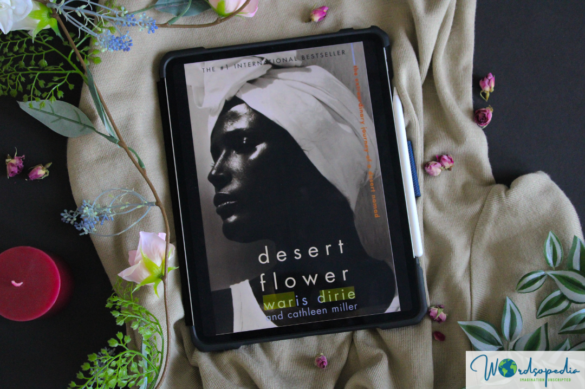
Desert Flower: The Extraordinary Journey of a Desert Nomad is Waris Dirie ’s memoir. A Somali model and human rights activist, in this book Dirie anecdotes her life journey – a journey filled with obstacles and her never say die spirit. The writing is raw and unpolished, mirroring the author’s frame of mind and emotions. At times, it feels like a conversation, rather than reading a book.

Born in a nomadic tribe in Somalia, Dirie’s story is distressing and inspiring. Raised in poverty, an uneducated Dirie has a tough childhood. Herding goats and camels, moving from one place to another in search of food and water; daily struggles for survival are an integral part of her life.
Her tribe practices circumcision as it is an excellent investment, and ‘cut’ daughters would fetch a good price. Like the other women of their tribe, Dirie is mutilated at the tender age of 5. Her traumatic memories torment her forever and lead her to fight for a cause she truly believes in—abolishing Female Genital Mutilation (FGM is a procedure which involves cutting of the female genitals. Also known as female circumcision or cutting, it is prevalent in Africa, Middle East and Asia. By this practice, the elders ensure the virginity of girls till marriage. Unfortunately, even after giving birth, their vaginas are stitched again so that the husband wouldn’t be denied pleasure.)
When Dirie turns 12, her father receives a hard to refuse proposal. 5 camels for marrying his daughter to an older man! Her pleas with her father fall on deaf ears, and she has only one option—to run away. She embarks on a harrowing and dangerous journey in search of safety. Illiterate, scantily dressed, and bare-foot, her journey is filled with dangers—from both men and wild animals. Finally, she makes it to Mogadishu, to an uncle’s place.
But she doesn’t stop there. Life takes her to London, where she works as a maid in her aunt’s house. With a bit of luck, help from friends, and a lot of hard work, Dirie enters the fashion industry and scales to the top. But success and fame don’t come easily. There are a lot of compromises she has to make, some quite dangerous and illegal too.
Waris Dirie’s memoir is both a personal and political story. It is about her life and struggles, and also is a reflection of the customs, rituals and pathetic condition of women in Somalia. Females are at the mercy of men-folk. Leading meek lives, satisfying the sexual needs of their husbands and giving birth to many children is what society expects of them.
Dirie’s undying spirit helped her change her fate. She is undoubtedly an inspiring woman. She has opened her life to the world, and is it requires a lot of courage to write such an honest memoir; for she is bound to receive criticism for the choices she made, or the way she acted with certain people and in different situations.
It is a motivating read, but fails as regards its disjointed narration and the diction.
There is no streamlined flow, and the shifting timelines and locales add to the confusion. I felt the profanity could have been reduced, or done away with. Also, there is way too much onomatopoeia!
There are certain parts which could have been written better, especially the one where she meets her mother after years. I am certain it would have been an emotional moment, but the writing failed to reflect it. A better editing would have helped in polishing those rough edges. This book is worth reading, despite the shoddy editing.
With great honesty, Waris Dirie shares not only the painful details of her tough life in Somalia but also the real-life struggle behind the glitz and glamor of modelling world.
Desert Flower is an inspiring tale of a brave and determined woman who beat all odds to survive and shine.
Wordsopedia rating: 4/5
Buy your copy here on Amazon
About the Author
Waris Dirie is a Somali model, author, actress and human rights activist in the fight against Female Genital Mutilation. From 1997 to 2003, she was a UN special ambassador against female genital mutilation. In 2002, she founded her own organization in Vienna, the Desert Flower Foundation.
Get in touch with the author on her website .
By subscribing, you agree to our website terms and conditions.
Check your inbox or spam folder to confirm your subscription.
The Night Gardener
Dawn and the witch of glacius, you may also like, the himadripuram adventure, silent sister, vivekananda, the spice maker’s secret, the djinn’s apple, no funeral for nazia, smoke and ashes, how to solve your own murder, leave a comment cancel reply.
Save my name, email, and website in this browser for the next time I comment.
Desert Flower

48 pages • 1 hour read
Desert Flower: The Extraordinary Journey of a Desert Nomad
A modern alternative to SparkNotes and CliffsNotes, SuperSummary offers high-quality Study Guides with detailed chapter summaries and analysis of major themes, characters, and more.
Chapter Summaries & Analyses
Chapters 1-6
Chapters 7-12
Chapters 13-18
Key Figures
Symbols & Motifs
Important Quotes
Essay Topics
Discussion Questions
Chapters 1-6 Chapter Summaries & Analyses
Chapter 1 summary: “running away”.
Content Warning: This section of the guide contains descriptions of female genital mutilation , rape, and attempted rape.
The novel opens in Somalia. Waris Dirie , a 13-year-old girl, wakes up from a nap under a tree. A lion is standing over her, and Dirie is sure that she is about to die. Inexplicably, the lion does not attack her and leaves.
Get access to this full Study Guide and much more!
- 7,600+ In-Depth Study Guides
- 4,850+ Quick-Read Plot Summaries
- Downloadable PDFs
Dirie is trying to reach the city of Mogadishu. She has run away from her family, who are nomads traveling through the desert, because she does not want to marry the 60-year-old man to whom she is betrothed. Dirie’s father tracks her and follows her, but she manages to escape him.

Don't Miss Out!
Access Study Guide Now
Featured Collections
Books that Feature the Theme of...
View Collection
Feminist Reads
Sexual Harassment & Violence
Women's Studies

- Desert Flower TV
Waris Dirie
Waris dirie was born as a daughter of a nomadic family in 1965 in the region of gallacaio, in the somali desert on the border with ethiopia..
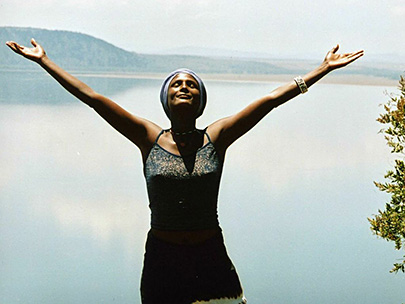
At the age of five years, she suffered the inhumane procedure of female genital mutilation. This terrible crime against women is practiced worldwide by Muslims and Christians.
According to WHO estimates, 8,000 girls become victims of this incredible brutality every day.
At the age of 13, Waris fled from a forced marriage with a man who could have been her grandfather. After an adventurous escape, she arrived in London and worked as a housemaid and at McDonalds.
Supermodel + Bond Girl
At the age of 18, she was discovered as a model by the famous british celebrity- photographer, terence donovan, and photographed for the pirelli calender..

She moved from London to New York and became one of the first African Supermodels receiving an exclusive agreement with the cosmetic group Revlon. She also graced the front pages of all the major magazines.
She appeared as a James Bond Girl, alongside Timothy Dalton in “The Living Daylights”.
The BBC commissioned the programme “A Nomad in New York”, based on Waris Dirie for their series “The day that changed my life”.
The US based famous journalist, Barbara Walters, interviewed her on behalf of NBC. Waris was also interviewed by Laura Ziv for the magazine Marie Claire, in which she decided to tell about the cruel ritual of female genital mutilation and also her own destiny resulting in a wave of sympathy and protest worldwide against FGM.
Human Rights Activst
Un secretary general kofi annan appoints waris as goodwill ambassador in the fight against female genital mutilation..
She travels on behalf of the United Nations around the world, participates in conferences, meets presidents, Nobel Prize winners and movie stars and gives hundreds of interviews to draw attention to her mission.
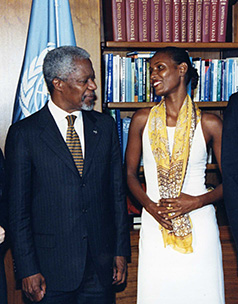
Awards and Honours
Waris Dirie has received many prestigious prizes and awards for her work and books, such as the “Women’s World Award” by President Mikhail Gorbachev (2004), the “Bischof Oscar Romero Preis” by the Catholic Church (2005), the “Woman of the Year Award” by the magazine “Glamour”(2000), the “Afrika Preis” by the german Federal Government and the “Corinne Award” by the holding organization of the German Book Trade for the best factual book.
In 2007 the French President Nicolas Sarkozy presented her with the “Chévalier de la Légion d’Honneur”. The World Demographic Association nominated her as the first woman for the “Prix de la Gènèration” and the Martin Buber Foundation nominated her as the first woman for the “Martin Buber Gold Medal”.
Desert Flower Foundation
In 2002 she founded her own foundation, called “waris dirie foundation” to support her work as a campaigner against fgm..
In 2010, the Foundation was re-named “Desert Flower Foundation” to reflect the broader approach to addressing Female Genital Mutilation though economic projects in Africa.
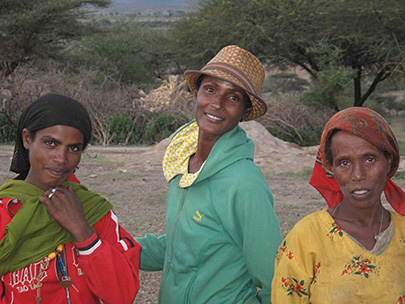
Currently, the organization has international headquarters in Vienna, Austria and has regional offices in Germany, Switzerland, the Netherlands, Monaco, France, Spain, the United Kingdom, Sweden, Djibouti , Sierra Leone and Poland. The official languages are English, German, Polish, Dutch, French and Spanish.
The foundation’s team is made up of men and women committed to gender equality, human rights and all of them share Waris Dirie’s ideal: Ending Female Genital Mutilation.
The Desert Flower Foundation and all its campaigns, projects and activities are financed by private donations.
The key work aspects of the Desert Flower Foundation are:
Raise Awareness
Through workshops, seminars, conferences, presentations, charity events, online campaigns etc.
Prevention work
Through projects like “Save a little desert flower”, which seeks to protect little girls in Africa from FGM.
Damage Repair
Through our Desert Flower Centers we try to help and guide victims of FGM to regain, as much as possible, their life quality and confidence.
Desert Flower
In 1997 Harper Collins in New York published Waris Dirie’s biography “Desert Flower” and the book quickly became an international bestseller. Since then, the book has been published in 65 licensed editions, was number 1 on the bestseller lists in many countries (in Germany, for example, the book stayed in the Top Ten list of best-selling books published in the magazine ‘Der Spiegel’ for a total of 120 weeks) and has sold more than 11 million copies worldwide.
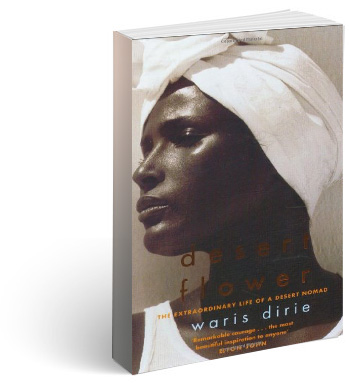
From a nomadic life in the Somali desert, to the most exclusive designer runways in the world – a wonderful dream. But also a nightmare, because Waris Dirie became a victim of a cruel ritual when she was five years old: she got circumcised. In “Desert Flower” she breaks through her longstanding silence and tells her touching story. Today she is fighting as UN Ambassador against female genital mutilation, which happens to 8,000 girls every day. ››I know that “Desert Flower” contains an important message which is shared by all people: the respect for human dignity. « Waris Dirie
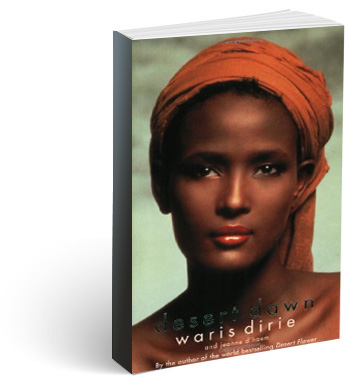
Desert Dawn
After 20 years, Waris Dirie initially returns to Somalia and meets her family again. After such a long time in the western world, Waris's arrival in her homeland, most of all her reunion with her mother and also the dispute with her former life, will be a personal challenge for her. In the fascinating resumption of her autobiography “Desert Flower”, Waris Dirie conveys a compelling and touching picture of life in Somalia: on the one hand, a great variety of traditions but on the other hand, the archaic distribution of roles, which particularly puts the country´s women in chains.

Desert Children
Bestselling author and UN Ambassador Waris Dirie, who experienced the horrible agony of FGM when she was five years old, was the first woman who spoke about this terrible torture in public. Now she continues the story of her life, from the day she broke her silence: Waris reports about encounters with victims and perpetrators, about tiring research, and from throwbacks to successes. “Desert Children” is in many ways a shocking book but it is also a book full of strength and hope for millions of women worldwide.

Letter to my mother
UN Ambassador Waris Dirie shows herself from a very personal side: as a tireless fighter against the ritual mutilation of women – mainly because of her own, painful experience. The words Waris Dirie could never say to her own mother, she puts down in a long, emotional letter. Prosecution and reconciliation are considered at the same time, and she writes relentlessly openly about the dark side of her modelling career, which drove her to alcohol abuse. Ulrike Hübschmann transforms this letter very emotional.

Black Women, White Country
Waris Dirie was born in the African Desert, and she stayed a nomad her whole life. The “white country” is too cold and dismissive for her to put down roots. Despite her international success as a model and her commitment to Women´s Rights, Waris stays a “Black Woman”, who is always suspicious to the police and a sex object for men. However, her country of origin is also strange to her. Waris Dirie speaks in her book about her anger towards Africa, a continent dominated by corruption and daily violence. As she gives birth to her son, Leon, she resolves to give to her child, what she has never had herself: a real home.
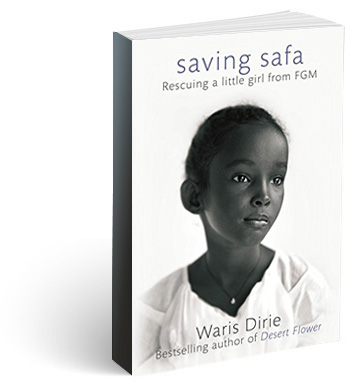
Little Safa comes from a bitterly poor family in Djibouti. Grown up in a slum, she was chosen for the role of Waris as a child in the screening of the international bestseller “Desert Flower”. The dramatic scene, in which the little girl violently gets circumcised, brings people to tears worldwide. In reality, Safa is still not cut and Waris Dirie is horrified, as she gets informed that the cutting ritual is imminent. She does her utmost to save little Safa from this terrifying destiny.
Desert Flower - The Movie
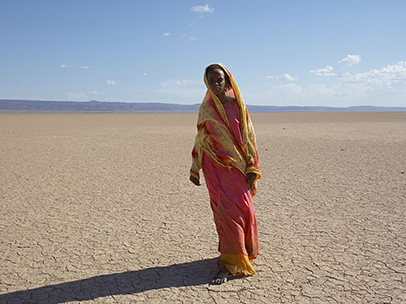
In March 2008 producer and Oscar-winner Peter Hermann (“Nowhere in Africa”) commenced with the shooting of “Desert Flower” (the budget: USD 16 Mio). The initial filming took place in Djibouti with mostly amateur actors. Further locations included New York, Berlin and London. Waris Dirie served as associate producer for the film, which was directed by Sherry Hormann.
Waris Dirie is played by an Ethiopian supermodel and the face of Estee Lauder, Liya Kebede, who had already played roles in two big productions: “The Good Shepherd” directed by Robert De Niro and “Lord of War” by Nicolas Cage.
In the movie we also see other prominent actors, such as Sally Hawkins (“Happy Go Lucky”, “Cassandra's Dream”), Timothy Spall (“Harry Potter”, “Vanilla Sky”), Meera Syal (“Scoop”, “Anita and Me”), Juliette Stevenson (“Bend It Like Beckham”) and Craig Parkinson (“Control”).

- Biographies & Memoirs
- Arts & Literature

Enjoy fast, free delivery, exclusive deals, and award-winning movies & TV shows with Prime Try Prime and start saving today with fast, free delivery
Amazon Prime includes:
Fast, FREE Delivery is available to Prime members. To join, select "Try Amazon Prime and start saving today with Fast, FREE Delivery" below the Add to Cart button.
- Cardmembers earn 5% Back at Amazon.com with a Prime Credit Card.
- Unlimited Free Two-Day Delivery
- Streaming of thousands of movies and TV shows with limited ads on Prime Video.
- A Kindle book to borrow for free each month - with no due dates
- Listen to over 2 million songs and hundreds of playlists
- Unlimited photo storage with anywhere access
Important: Your credit card will NOT be charged when you start your free trial or if you cancel during the trial period. If you're happy with Amazon Prime, do nothing. At the end of the free trial, your membership will automatically upgrade to a monthly membership.
Buy new: .savingPriceOverride { color:#CC0C39!important; font-weight: 300!important; } .reinventMobileHeaderPrice { font-weight: 400; } #apex_offerDisplay_mobile_feature_div .reinventPriceSavingsPercentageMargin, #apex_offerDisplay_mobile_feature_div .reinventPricePriceToPayMargin { margin-right: 4px; } -35% $11.69 $ 11 . 69 FREE delivery Tuesday, May 14 on orders shipped by Amazon over $35 Ships from: Amazon.com Sold by: Amazon.com
Return this item for free.
Free returns are available for the shipping address you chose. You can return the item for any reason in new and unused condition: no shipping charges
- Go to your orders and start the return
- Select the return method
Save with Used - Very Good .savingPriceOverride { color:#CC0C39!important; font-weight: 300!important; } .reinventMobileHeaderPrice { font-weight: 400; } #apex_offerDisplay_mobile_feature_div .reinventPriceSavingsPercentageMargin, #apex_offerDisplay_mobile_feature_div .reinventPricePriceToPayMargin { margin-right: 4px; } $7.06 $ 7 . 06 FREE delivery Tuesday, May 14 on orders shipped by Amazon over $35 Ships from: Amazon Sold by: Jenson Books Inc

Download the free Kindle app and start reading Kindle books instantly on your smartphone, tablet, or computer - no Kindle device required .
Read instantly on your browser with Kindle for Web.
Using your mobile phone camera - scan the code below and download the Kindle app.

Follow the authors

Image Unavailable

- To view this video download Flash Player
Desert Flower: The Extraordinary Journey of a Desert Nomad Paperback – March 15, 2011
Purchase options and add-ons.
"Waris's story is one of remarkable courage. From the deserts of Somalia to the world of high fashion, she battles against oppression and emerges a real champion. She is the most beautiful inspiration to anyone." —Elton John
Waris Dirie ran away from her oppressive life in the African desert when she was barely in her teens, illiterate and impoverished, with nothing to her name but a tattered shawl. She traveled alone across the dangerous Somali desert to Mogadishu—the first leg of a remarkable journey that would take her to London, where she worked as a house servant; then to nearly every corner of the globe as an internationally renowned fashion model; and ultimately to New York City, where she became a human rights ambassador for the U.N.
Poignant and powerfully told, Desert Flower is Waris's extraordinary story.
- Print length 256 pages
- Language English
- Publication date March 15, 2011
- Dimensions 6.12 x 0.62 x 9.25 inches
- ISBN-10 9780688172374
- ISBN-13 978-0688172374
- See all details

Frequently bought together

Customers who viewed this item also viewed

Editorial Reviews
From the back cover.
Waris Dirie ran away from her oppressive life in the African desert when she was barely in her teens, illiterate and impoverished, with nothing to her name but a tattered shawl. She traveled alone across the dangerous Somali desert to Mogadishu—the first leg of a remarkable journey that would take her to London, where she worked as a house servant; then to nearly every corner of the globe as an internationally renowned fashion model; and ultimately to New York City, where she became a human rights ambassador for the U.N. Desert Flower is her extraordinary story.
About the Author
An internationally recognized supermodel, Waris Dirie is a United Nations special ambassador who travels the world as an articulate and passionate advocate of human rights. She served as United Nations special ambassador for the elimination of FGM. She has since established the Desert Flower Foundation to advance women’s rights in Africa.
Cathleen Miller circled the globe to interview sources for her latest book, Champion of Choice , the biography of UN leader Nafis Sadik. Her previous work includes the international bestseller Desert Flower , which was adapted as a feature film. Miller’s travel essays have appeared in the Washington Post, Chicago Tribune, San Francisco Chronicle and Los Angeles Times .
Product details
- ASIN : 0688172377
- Publisher : William Morrow Paperbacks (March 15, 2011)
- Language : English
- Paperback : 256 pages
- ISBN-10 : 9780688172374
- ISBN-13 : 978-0688172374
- Item Weight : 11 ounces
- Dimensions : 6.12 x 0.62 x 9.25 inches
- #454 in Feminist Theory (Books)
- #2,989 in Women's Biographies
- #8,115 in Memoirs (Books)
About the authors
Waris dirie.
Discover more of the author’s books, see similar authors, read author blogs and more
Cathleen Miller
An American by birth, Cathleen Miller has traveled around the globe to write her books telling the stories of people and places. She has interviewed diplomats and heads of state on five continents, patients in an Addis Ababa hospital, rape camp survivors in Kosovo, and midwives in the mountains of East Timor. Her work sometimes places her in strange circumstances, for example cruising St. Petersburg in a Winnebago to interview prostitutes, and running down a Brazilian mountain at midnight fleeing bandits. Cathy’s biography of Nafis Sadik, Champion of Choice, is the result of ten years of work and many, many strange circumstances.
Cathy’s previous work includes the international bestseller Desert Flower, which has been translated into 55 languages and adapted as a feature film shown around the globe. In both Desert Flower and Champion of Choice, Cathy utilizes storytelling as a rhetorical device to demonstrate how the issues which affect one individual are representative of a larger world order. The personal is political.
Cathy is also the author of a memoir about her life in rural Pennsylvania, The Birdhouse Chronicles, a book first written as her master’s thesis while she attended Penn State’s MFA program in creative writing. Birdhouse received a Pushcart Prize nomination.
A winner of the Society of American Travel Writers gold award, Cathy’s travel essays have appeared in the Washington Post, Chicago Tribune, San Francisco Chronicle, and Los Angeles Times. They are included in the collection Wild Writing Women: Stories of World Travel.
Cathleen Miller taught creative writing at San José State University, where today she is an emeritus professor. She’s an accomplished public speaker who has performed at numerous venues, including Cinequest, LitQuake, the Ford Foundation, the United Nations Foundation, the Women, Peace and Conflict Lecture and Film Series, and the American Women’s Association of Rome. She’s also featured in a Ted Talk on a topic dear to her heart: “How to Raise Your Daughter to Become a World Leader.”
Customer reviews
Customer Reviews, including Product Star Ratings help customers to learn more about the product and decide whether it is the right product for them.
To calculate the overall star rating and percentage breakdown by star, we don’t use a simple average. Instead, our system considers things like how recent a review is and if the reviewer bought the item on Amazon. It also analyzed reviews to verify trustworthiness.
Reviews with images

- Sort reviews by Top reviews Most recent Top reviews
Top reviews from the United States
There was a problem filtering reviews right now. please try again later..
Top reviews from other countries
- Amazon Newsletter
- About Amazon
- Accessibility
- Sustainability
- Press Center
- Investor Relations
- Amazon Devices
- Amazon Science
- Sell on Amazon
- Sell apps on Amazon
- Supply to Amazon
- Protect & Build Your Brand
- Become an Affiliate
- Become a Delivery Driver
- Start a Package Delivery Business
- Advertise Your Products
- Self-Publish with Us
- Become an Amazon Hub Partner
- › See More Ways to Make Money
- Amazon Visa
- Amazon Store Card
- Amazon Secured Card
- Amazon Business Card
- Shop with Points
- Credit Card Marketplace
- Reload Your Balance
- Amazon Currency Converter
- Your Account
- Your Orders
- Shipping Rates & Policies
- Amazon Prime
- Returns & Replacements
- Manage Your Content and Devices
- Recalls and Product Safety Alerts
- Conditions of Use
- Privacy Notice
- Consumer Health Data Privacy Disclosure
- Your Ads Privacy Choices
- Free Samples
- Premium Essays
- Editing Services Editing Proofreading Rewriting
- Extra Tools Essay Topic Generator Thesis Generator Citation Generator GPA Calculator Study Guides Donate Paper
- Essay Writing Help
- About Us About Us Testimonials FAQ
- Studentshare
- Journalism & Communication
- Desert Flower by Waris Dirie
Desert Flower by Waris Dirie - Essay Example

- Subject: Journalism & Communication
- Type: Essay
- Level: Undergraduate
- Pages: 14 (3500 words)
- Downloads: 4
- Author: liam82
Extract of sample "Desert Flower by Waris Dirie"
- Cited: 1 times
- Copy Citation Citation is copied Copy Citation Citation is copied Copy Citation Citation is copied
CHECK THESE SAMPLES OF Desert Flower by Waris Dirie
Poverty and relationship development, business operations and systems, euripedes, medea- desert flower- woman at point zero, will the oil crisis happen, relative immaturity of romeo and juliet, antarctic sea ice melt and its implications, security threat groups/gangs in prison, salome dancing before herod by gustave moreau.

- TERMS & CONDITIONS
- PRIVACY POLICY
- COOKIES POLICY
Sample details
- Words: 1324
- Views: 1,133
Related Topics
- Precipitation
- North America
- Underground
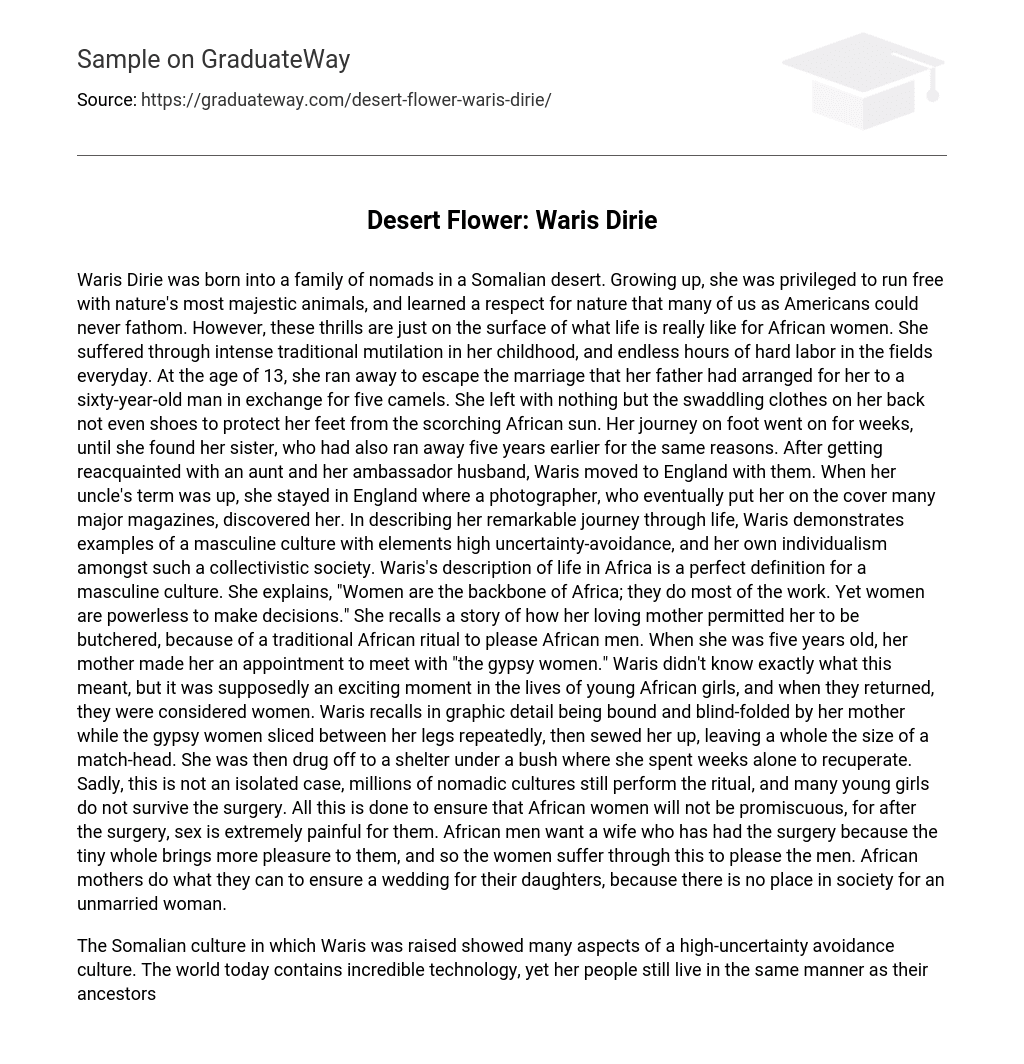
Desert Flower: Waris Dirie Analysis
Waris Dirie was born into a family of nomads in a Somalian desert. Growing up, she was privileged to run free with nature’s most majestic animals, and learned a respect for nature that many of us as Americans could never fathom. However, these thrills are just on the surface of what life is really like for African women. She suffered through intense traditional mutilation in her childhood, and endless hours of hard labor in the fields everyday. At the age of 13, she ran away to escape the marriage that her father had arranged for her to a sixty-year-old man in exchange for five camels. She left with nothing but the swaddling clothes on her back not even shoes to protect her feet from the scorching African sun. Her journey on foot went on for weeks, until she found her sister, who had also ran away five years earlier for the same reasons. After getting reacquainted with an aunt and her ambassador husband, Waris moved to England with them. When her uncle’s term was up, she stayed in England where a photographer, who eventually put her on the cover many major magazines, discovered her. In describing her remarkable journey through life, Waris demonstrates examples of a masculine culture with elements high uncertainty-avoidance, and her own individualism amongst such a collectivistic society. Waris’s description of life in Africa is a perfect definition for a masculine culture. She explains, “Women are the backbone of Africa; they do most of the work. Yet women are powerless to make decisions.” She recalls a story of how her loving mother permitted her to be butchered, because of a traditional African ritual to please African men. When she was five years old, her mother made her an appointment to meet with “the gypsy women.” Waris didn’t know exactly what this meant, but it was supposedly an exciting moment in the lives of young African girls, and when they returned, they were considered women. Waris recalls in graphic detail being bound and blind-folded by her mother while the gypsy women sliced between her legs repeatedly, then sewed her up, leaving a whole the size of a match-head. She was then drug off to a shelter under a bush where she spent weeks alone to recuperate. Sadly, this is not an isolated case, millions of nomadic cultures still perform the ritual, and many young girls do not survive the surgery. All this is done to ensure that African women will not be promiscuous, for after the surgery, sex is extremely painful for them. African men want a wife who has had the surgery because the tiny whole brings more pleasure to them, and so the women suffer through this to please the men. African mothers do what they can to ensure a wedding for their daughters, because there is no place in society for an unmarried woman.
The Somalian culture in which Waris was raised showed many aspects of a high-uncertainty avoidance culture. The world today contains incredible technology, yet her people still live in the same manner as their ancestors thousands of years ago. Their society has stayed virtually unchanged, and not because of chance, but choice. This avoidance is demonstrated by Waris’s translator at one point in her life. After finally coming clean with her doctor about the reason she had such intolerable periods in which she could not function for seven days, he insisted that she get the circumcision from her childhood reversed as soon as possible. To discuss the details of the operation, the doctor hired a translator, for her English was not yet fluent. To her dismay, the translator was a Somalian male who scorned her about going against their custom. He was offended that Waris would deviate from the tradition, regardless of the pain that she experienced because of it. He didn’t question that the procedure was inappropriate, just accepted it as culture. This is why the rules and rituals in that society have remained the same for so many years; they are not questioned, just followed. The people have faith that these practices are right under God, and therefor they continue.
ready to help you now
Without paying upfront
Regardless of her strictly collectivistic upbringing, Waris throughout her life demonstrated her own individualism. First, by running away to avoid marriage. Though her family would benefit from her marriage, she knew it would not make her happy. She stood up for herself, and ran away to start a new life. After enduring years of urinating drop at a time and unbearable menstruation periods, Waris acted independently and went to the doctor. The translator’s comments, as I mentioned earlier, made her think twice. Despite her doubts, she had the surgery; she writes, “there’s no way to explain what a freedom that was.” Later, Waris sought out her mother in Somalia after years of separation. Her mother wasn’t sure about Waris’s new way of life, but was most adamant about the fact that she was not married. Waris expressed her individualistic views by remarking, ” Mama, do I have to be married? Don’t you want to see me a success-strong and independent?” This is an idea her mother had probably not ever entertained; she didn’t question their culture as Waris did. She just responded with “Well, I want grandchildren.” Waris’s individualism may be looked at as rebellion or selfish. Whichever way it is viewed, her independent nature is a key factor in how she ended up a successful woman.
Waris’s story also demonstrates a collective culture. When writing about her life growing up, she mentions “my life had been built around nature and family.” Waris was always tending to the crop of watching the goats to ensure that the family had food. Everything that was done was done for the good of the family and everyone was expected to act unselfishly. She mentions that none of her family members, including herself, have any idea how old they are. In a society that throws huge celebrations when someone turns a year older, and almost everything is based on age, this is “weird” to us as Americans. However, it is completely normal for them, because they are not preoccupied with “I”. Americans worry about age because they long for more independence. For example: when we can drive, legally leave home, drink, or vote. None of these issues are of any importance to Africans because they are only concerned with what will be good for the family unit. Regardless of the pain Waris’s mother felt for her daughter as she underwent the circumcision, she permitted it because of her collectivism, a feeling of obligation and loyalty to the group. This is an example of how collectivistic cultures put the needs of the group above the needs of the individual. Today, Waris bravely and openly speaks about such private rituals as the circumcisions. Her friends are afraid that an angry nomad might seek her out and kill her for speaking of the holy practice, yet she continues in hopes that one day it will become a thing of the past. Before reading this article, I could never imagine that something so gruesome is still going on somewhere today. Living in a society so opposite to Africa’s, a lot of the issues presented in the article were new to me, and I did learn a lot. Most of all a respect for African women, who demonstrate incredible loyalty, unselfishness, and strength by living in pain, for the sake of tradition. I think what Waris is making a valiant effort, yet I have to wonder how much good it will do. The practice has been going on for thousands of years, and she cannot possibly change the minds of millions of people who so strongly believe in the traditions. However, if she changes the minds of just one, then the life of a young girl might be saved.
Cite this page
https://graduateway.com/desert-flower-waris-dirie/
You can get a custom paper by one of our expert writers
- Natural Resources
- Temperature
- Middle East
Check more samples on your topics
Analysis of frost’s “desert places” and “stopping by woods on a snowy evening”.
Stopping by Woods on a Snowy Evening
Robert Frost takes our imaginations to a journey through wintertime withhis two poems "Desert Places" and "Stopping by Woods on a Snowy Evening". Frostcomes from a New England background and these two poems reflect the beautifulscenery that is present in that part of the country. Even though these poemsboth have winter settings they contain very
Flower References in Chronicle of a Death Foretold Analysis
Chronicle of a Death Foretold
Rachel Sexton Flower References In the 1950s, Colombian culture was very biased towards gender and their roles in society. As in many other countries, women were seen as a lower class compared to men. Women were only valued for being a good mother, wife, and caretaker. In Chronicle of a Death Foretold, Gabriel Garcia Marquez
“The Flower-Fed Buffaloes” by Lindsay Analysis
American frontier
The Flower-Fed Buffaloes is a slow and rhythmic poem, which uses many aural effects, emotive language and techniques to create a powerful lament on the destruction of the world. Lindsay often portrays the destruction with scenes from the American ‘Wild West’. Lindsay writes, “Ranged where the locomotives sing and the prairie flowers lie low”. Here
Literary on ‘The devil in the desert’ by Paul Horgan
“The devil in the desert” short story by Paul Horgan (1903-1995) was written in the year 1950. It is a story that features the adventure of an elderly priest who leaves a missionary centre to go preaching to a tribe of Indians that lives in a desert land. At the start of the story, Louis, the
The Desert Palms Hotel & Casino Short Case Study
Case Study Analysis Desert Palms Hotel and Casino has a great potential in growing and expanding. Having Robert Hoffman as its general manager gives the company edge over other competitors due to his management abilities and skills that he gained through years of hard work. The plan of establishing a water park can increase revenues
How the fennec fox (Vulpes zedra) has adapted to the desert environment.
Environment
How the fennec fox( Vulpes zedra )has adapted to the desert environment.The fennec fox is the smallest member of theVulpesgenus ( officially in theFennecusgenus ) merely weighing 2.2 – 3.3 pound. It is extremely distinguishable by its immense ears mensurating 6 inches, and a organic structure length of up to 16 inches. It is a
Essay – Camels and the Desert
Over 3,000 years in the past, Arabia witnessed the domestication of an ungainly but useful desert creature - the Arabian camel. This long-legged creature sported a single hump on its back and possessed remarkable abilities: it could traverse scorching deserts with minimal water intake and bear heavy burdens without exhaustion. Another variety, the two-humped Bactrian
Desert and its Inhabitants
The desert is a biome or as a life zone, for example another biome would be tundra. The desert in western United States in caused by the coastal ranges and the gigantic Sierras in California. These mountains cause the clouds to rain and by the time they reach the other side, there is little or
The People of the Kalahari Desert
Part OneIntroduction, Location and EnvironmentThe people of the Kalahari desert are extraordinary people. For centuries their hunting and food gatheringtechniques have enabled them to survive in the difficult environment of the dry, hot and barren Kalahari desert. They are known as the Bushmen. Or the Kung or the Gikwe since Bushmen is rather discriminating because the"Bushmen"

Hi, my name is Amy 👋
In case you can't find a relevant example, our professional writers are ready to help you write a unique paper. Just talk to our smart assistant Amy and she'll connect you with the best match.
Tasks and Activites
Tasks: Desert Flower
Understanding the film:.
Work with a partner in a shared document, and write the answers to the questions together.
- As a child Waris Dirie was subjected to female genital mutilation. How did it happen?
- Waris runs away to her maternal grandmother in Mogadishu. Why did she choose to leave home?
- Waris is sent to work for a family member at Somalia's embassy in London. How is she treated there?
- When the government in Somalia is replaced, the people who work at the embassy have to leave. What happens to Waris?
- How does Waris meet Marilyn?
- What role does Harold Jackson play in the story?
- How does Waris become a fashion model?
- Why does Waris marry Neil? Is it a happy marriage?
- Why does Waris decide to share her story?
- Waris gives a speech before the UN. Why was the speech so important?
Fill in the missing words:
Use what you remember from the film and context from the sentences to fill in the correct words.
Below you find some statements made by Waris Dirie. Discuss what Dirie is saying in each of the quotations. Do you agree with her?
You can work with a partner or in a group.
- Women’s loyalty has to be earned with trust and affection rather than barbaric rituals. The time has come to leave the old ways of suffering behind.
- Fashion is fun, ridiculously fun. But it's base and it's wrong. You're not doing anything good for the world. You're just saying, "Buy it, buy it, buy it".
- I love the truth. Tell the truth and live the truth, because we've seen enough lies, and look what it's doing.
- Every day, women move mountains. It is an insult to have an international women's day.
- These tribal wars, like the practice of circumcision, are brought about by the ego, selfishness, and aggression of men. I hate to say that, but it’s true. Both acts stem from their obsession with their territory – their possessions – and women fall into that category both culturally and legally. Perhaps if we cut their balls off, my country would become paradise.
Pick one of the tasks to research. Use what you find to make a factsheet about the topic. Compare your factsheet with a partner's and consider whether you should make revisions.
- Find out about female genital mutilation: What is it? How common is it in Somalia? How common is it in other countries? How many women does it affect? Where is it practised? What is being done to stop it? Is progress made to stop female genital mutilation?
- Find out about child marriage. How common is it in Somalia? How common is it in other countries? How many people does it affect? Where is it practised? What is being done to stop it? Is progress made to stop child marriage?
Pick one of the tasks and write a longer text. Make sure you give references and list sources you have used.
- Write an analysis of the film Desert Flower .
- Write a discussion text where you consider if respecting other cultures means that traditions such as child marriage and female genital mutilation must be accepted.
- Imagine that you are a Norwegian journalist who have travelled to Somalia to write a feature article about female genital mutilation. On your journey you meet women who carry out female genital mutilation, women who have been mutilated, husbands and fathers of women who have been mutilated, and representatives from the government. Write the feature article.
A feature article is longer than the average news article. A feature article is objective, fact-based and accurate, but journalists also focus on painting a picture and creating a feeling. The feature article is meant to educate but also to entertain.
Related content
The film Desert Flower tells the story of the Somali fashion model and women's rights activist Waris Dirie.
Cite or use
Learning content.
Movie Reviews
Tv/streaming, collections, great movies, chaz's journal, contributors, a brave and beautiful victim.

Now streaming on:
"Desert Flower" tells an extraordinary story in an ordinary way. It has a compelling message and surrounds it with biopic scenes that appear to be brought in from a different kind of movie. The effect is rather unsettling.
The film is based on the life of Waris Dirie, an international supermodel who began life as a member of a nomadic tribe in Somalia. As a child, she was circumcised, as is the custom in many African countries. An old woman in the desert cut away those parts that could someday allow her to feel sexual pleasure and sewed shut her labia — so her husband could be sure he had married a virgin when he cut it open.
Many die during or because of this barbaric mutilation, still widely practiced today, although not mentioned in the Koran or any other holy book. It is the practice of subjugating women, making them commodities and denying them the full lives they deserve. It rises from the woman-hating men who propagate it by refusing to marry any woman who hasn’t been "cut."
When Waris was sold as a young teenager to an old man who already had three wives, she simply left one day, walking hundreds of miles across desert and scrubland to seek her grandmother in Mogadishu. Amazingly, she found her — and was hired by an aunt in London to work as a maid. The film cuts between her experiences as a young girl and what happened in London, where she ran away, lived on the streets and was befriended by a ditzy shop girl named Marylin ( Sally Hawkins ).
Marylin found her a job in a fast food restaurant mopping floors, and that’s where she was "discovered" by the fashion photographer Terry Donaldson ( Timothy Spall ). Through him and a mercenary modeling agent named Lucinda ( Juliet Stevenson ), she rises not without difficulties to the top ranks of modeling. She eventually denounces genital mutilation before the United Nations — and becomes its spokeswoman against the practice.
So "Desert Flower" tells a rags-to-riches story, but it plays like two stories in conflict. Everything involving Waris in Africa or in London before her success feels true and heartfelt. Many later details are badly handled.
Waris is played by another model, Liya Kebede , herself a spectacular beauty. (A question that arises: Why did it take so long for her to be "discovered"?) The film, written and directed by Sherry Hormann , lingers unnecessarily on several sexualized modeling sessions and teases us with nude scenes. Two supporting characters, Lucinda and a janitor named Neil ( Craig Parkinson ), undergo puzzling personality changes at the convenience of the plot. A character named Harold Jackson ( Anthony Mackie ) exists exclusively for Idiot Plot purposes. And a jacket materializes after the point has been made that it was left behind.
Still, there are good things here. Sally Hawkins and Timothy Spall, familiar from Mike Leigh films, make their characters original and plausible. Meera Syal , as a rooming-house owner, steps in with some nice moments. And it’s a compliment, I think, that Liya Kebede is more convincing as Waris the waif than as Waris the model.

Roger Ebert
Roger Ebert was the film critic of the Chicago Sun-Times from 1967 until his death in 2013. In 1975, he won the Pulitzer Prize for distinguished criticism.

Now playing

Sheila O'Malley

It's Only Life After All

The Greatest Hits
Matt zoller seitz.

The First Omen
Tomris laffly.

Under the Bridge
Cristina escobar.

Rebel Moon - Part Two: The Scargiver
Simon abrams, film credits.

Desert Flower (2011)
Rated R for sexual situations and scenes related to genital mutilation
120 minutes
Timothy Spall as Terry
Sally Hawkins as Marylin
Craig Parkinson as Neil
Liya Kebede as Waris
Juliet Stevenson as Lucinda
Anthony Mackie as Harold
Written and directed by
- Sherry Hormann
Latest blog posts

The Problem and the Solution: Why Palpatine from Star Wars is One of the Great Movie Villains

A Good Reason to Be a Coward: Jim Cummings on The Last Stop in Yuma County

Launch Day for My Book, It's Time To Give a FECK! Book Tour Dates, Tamron Hall Show

Short Films in Focus: Floating Through the Nowhere Stream with Director Luis Grané
- Privacy Policy

- Houseplants
- Gardening And Landscaping
Types of Desert Flowers (With Pictures and Names) – Identification Guide
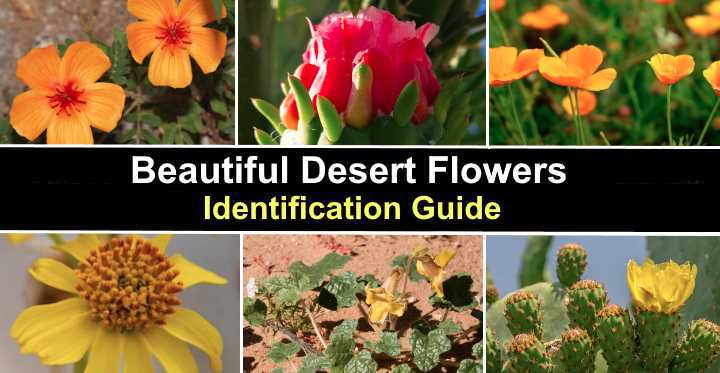
Desert flowers can bloom in the harshest and most arid environments in the country. A range of hardy flowering plants, blooming trees, and flowering cacti can turn a barren landscape into a colorful panorama with shades of yellow, orange, purple, pink, and red. Flowering desert plants are also ideal for beautifying garden landscapes if you live in a hot, dry climate.
Desert flowers are responsible for a spectacular phenomenon that occurs in many deserts — superbloom or desert bloom. This desert flowering event happens after an unusually wet rainy season. Moisture in the ground stimulates the growth and blooming of thousands of desert plants that all produce flowers simultaneously.
Of course, plants that flower and bloom in harsh desert conditions must be tolerant of drought, arid conditions, and constant sunshine. However, choosing the correct hardy plants can help you enjoy the beauty of desert flowers in your front or backyard. But what are the best flowers that bloom in the desert?
This article is an identification guide to choosing desert flowers for your yard. You will find descriptions and pictures of common flowering desert plants, flowering desert trees, and cacti that bloom annually.
Types of Flowers that Bloom in the Desert
Flowering plants in desert areas include California poppies, brittlebush, desert marigolds, and Arizona poppies. Some types of drought-tolerant flowering desert trees are the palo verde, mulga tree, and Anacacho orchid tree. In addition, many types of ornamental desert plants survive arid conditions because they have small, waxy leaves to reduce evaporation.
Desert Flowers (With Picture and Name) – Identification Guide
Desert flowers are native plants that thrive in arid climates where water is scarce. These drought-resistant plants are often found in dry regions in California , Arizona, New Mexico, and Texas . Desert flowers produce beautiful blossoms, and some even produce fruits.
Please read on to learn about plants that will flower in the desert.
Arizona Poppy Flowers ( Kallstroemia grandiflora )
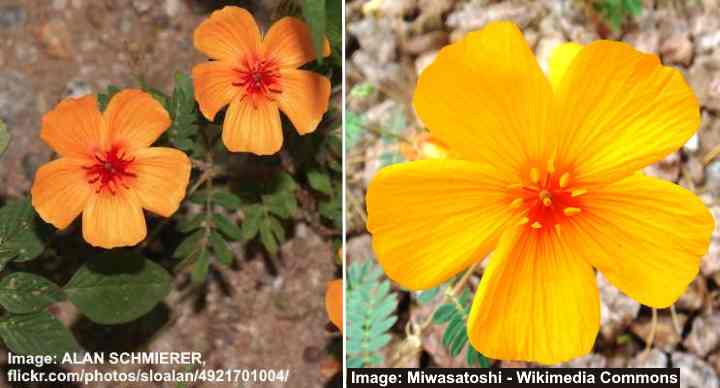
Arizona poppy is a low growing desert flowering plant with small orange or orange-yellow flowers
The Arizona poppy is one of the most spectacular flowering plants in the desert. This annual herbaceous desert plant has five-petalled orange or orange-yellow flowers that bloom abundantly after heavy rainfall. The trailing plant has small, pinnately compound leaves and hairy stems — two characteristic features of many desert flowering plants.
Identifying features of Arizona poppy flowers are the orange-yellow color and their bowl shape. The desert flowers measure 1” to 1.5” (2.5 – 3.8 cm) across and grow on stems 2” to 2.5” (5 – 6.3 cm) long. The small flowering plants are found in deserts in Arizona, Northern Mexico, and California.
Desert Marigold Flowers ( Baileya multiradiata )
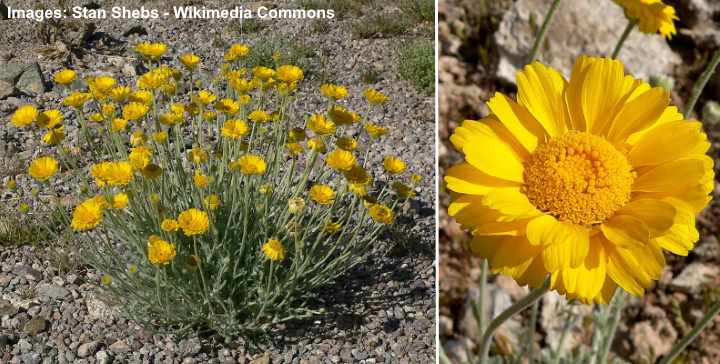
The yellow desert marigold flowers can brighten any desert landscaped garden
The desert marigold flower is identified by its brightly yellow color and disc-like shape. In addition, this short-lived perennial is characterized by silvery green leaves with a matt appearance. As a sun-loving desert wildflower, desert marigold has spreading habits and sometimes grows in clumps.
Yellow-flowering desert marigolds grow up to 20” (50 cm) tall. The easily recognizable feature of the desert plant is its marigold-like flowers measuring 2” (5 cm) across. The flowers bloom in the desert from early spring through late fall. This clumping desert plant thrives in poor, dry soils and hot conditions.
Marsh Aster Flower ( Aster pauciflorus )
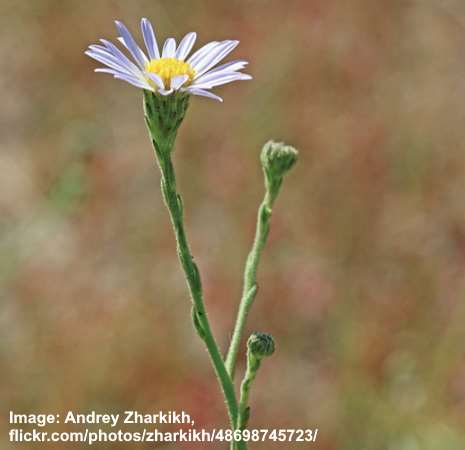
Marsh aster can be commonly found in desert salt marshes and can grow quite tall
The marsh aster is a common flowering plant found in deserts. The desert flowering marsh aster plant is identified by its disc-like flower head with narrow, spindly petals. The disc florets are typically a purple, lavender, or white color. Typically, 3 to 10 heads grow on stems. Technically a herb, marsh aster is found in the Mojave Desert and throughout the dry southern states.
Marsh aster is a perennial desert plant that spreads through creeping rhizomes. The plant, with its linear foliage, generally grows 12” to 47” (30 – 120 cm) tall. Under ideal conditions, marsh aster flowers from early summer through late fall in salt marshes and salt flats.
Brittlebush Flowers ( Encelia farinosa )
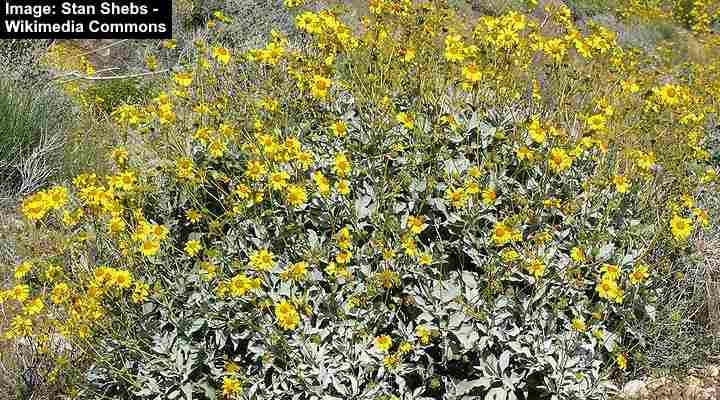
Brittlebush is a yellow flowering desert biome shrub with silvery-green foliage
Brittlebush is a flowering desert plant that has brightly colored yellow flowers arranged as ray florets. During dry, arid conditions in the desert, the plant sheds its leaves. However, it blooms spectacularly after heavy rain. Brittlebush is a classic desert plant and is typically one of the “superbloom” plants in California.
Brittlebush is a mounding shrub with silvery ovate, fragrant leaves. The bushy desert plant grows 12” to 60” (30 to 150 cm) tall. The small daisy-like yellow desert flowers stand erect above the pale green to velvety-silvery foliage.
Brittlebush is a desert plant that is ideal for planting in arid landscapes as a foundation planting , perennial border, or to accent flowering desert trees. In addition, the desert shrub will give gardens a splash of yellow color after rainfall.
Desert Primrose Flower ( Oenothera primiveris )
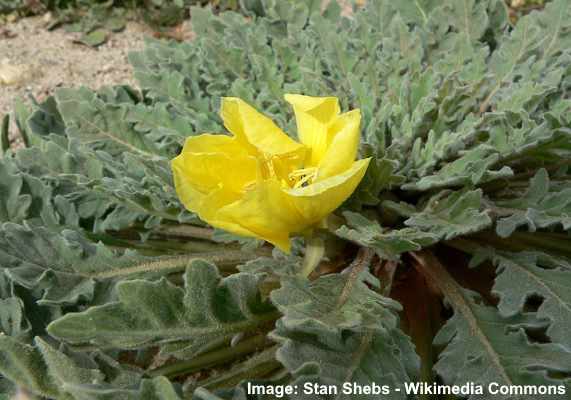
The yellow flowering desert primrose is a common desert plant with crinkly green-gray velvety leaves
Desert primrose is an herbaceous yellow-flowering desert plant with flowers consisting of large, showy golden yellow petals. Desert primrose has a feature of typical desert plants — fuzzy, dull green leaves to help prevent evaporation. The green or grayish leaves grow up to 11” (28 cm) long and are characterized by crinkly margins.
Related to the evening primrose plant, this common desert plant grows 14” (36 cm) tall. Desert primrose flowers have bright yellow color and large petals that are 1.6” (4 cm) long, which emerge yellow and fade to orange or red during the season. The sun-loving, drought-tolerant desert primrose plant is found in the southwestern United States.
California Poppy Flower ( Eschscholzia californica )
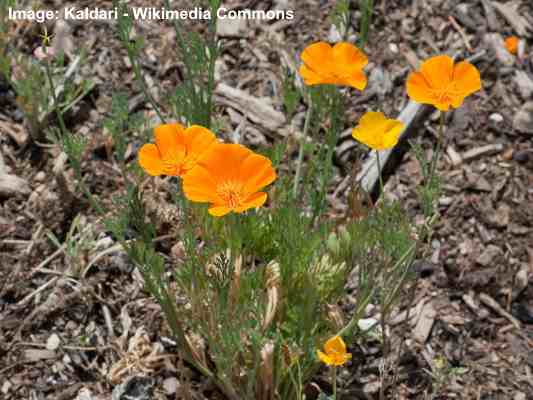
The California poppy is a fast growing desert wildflower with orange flowers that bloom after heavy rain
California poppy is a type of desert flowering plant that is identified by its warm orange cup-shaped flowers . The California poppy is an incredibly tough plant that thrives in desert conditions. The ornamental desert plant has thin green leaves, and spectacular blooming habit after heavy rains. The drought-resistant , self-seeding California poppy plant is ideal for landscaping sunny gardens as a flowering annual.
California poppies are a type of desert flowering plant that grows up to 2 ft. (0.6 m) tall and wide. The bushy plant is characterized by its mounding habit, fast growth, and orange or yellow flowers. This desert flower will bloom in any season after rainfall. The easy-care flowering plant is ideal for planting in arid landscapes.
Apache Plume Flowers ( Fallugia paradoxa )
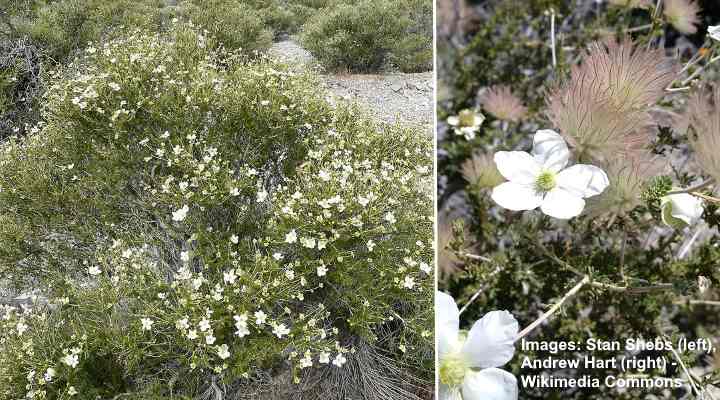
Apache plume is a white flowering desert shrub with feathery plumes that is good for preventing soil erosion
Apache plume is a large desert shrub with pure white flowers, tiny green leaves, and pinkish plume-like styles that remain after flowering. Like many desert plants, the foliage is slightly hairy and has a dull green color. The desert flowers consist of five rounded white petals measuring 2” across.
Apache plume shrubs are related to roses and are native to desert mountains and the southwestern United States. The large shrub grows 3 to 6 ft. (1 – 1.8 m) tall and 6 ft. (1.8 m) wide. Its most recognizable feature is its long feathery plumes emerging from the center of the white flowers.
The clumping Apache plume shrub is ideal for controlling soil erosion. You can also plant this flowering desert shrub in arid landscapes if you want to enjoy white blooms in harsh desert like-conditions.
Devil’s Claw Flower ( Proboscidea althaeifolia )
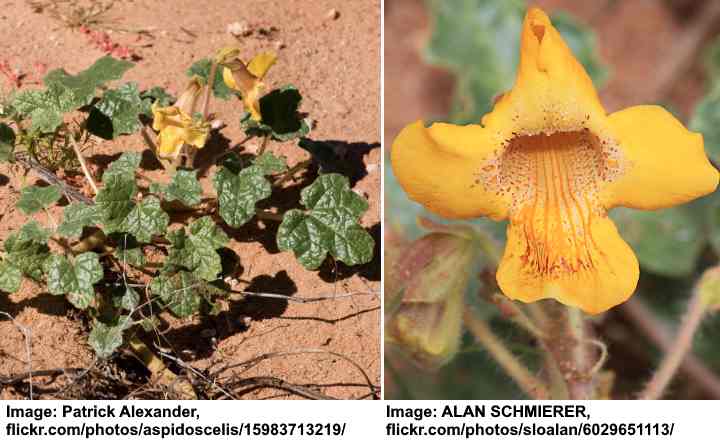
Devil’s claw is a low growing trailing desert flowering plant that can be used as a ground cover in sandy soils
Also called the yellow-flowered devil’s claw, this native desert plant thrives in hot summers and sandy environments. The flowering desert plant is a herb that blooms with fragrant, funnel-shaped orange-yellowish flowers. The creeping herbaceous plant has shiny, oval, or heart-shaped leaves with lobed, wavy margins. It’s a native plant in Arizona, California, and the Sonoran Desert.
The small, low-growing plant grows as a trailing vine in the desert up to 24” (60 cm) wide and 4” (10 cm) tall. Identifying characteristics of the devil’s claw are its large, curled seed pod 2.3” (6 cm) long and trumpet-like orange desert flowers with dark orange lines in the throat.
Fairy Duster Flower ( Calliandra eriophylla )
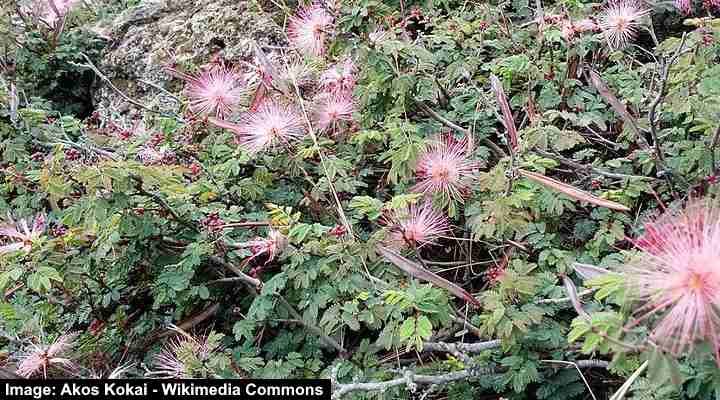
The fairy duster is a pink flowering desert shrub that can be used to landscape arid sunny gardens
Fairy duster is a low-spreading desert shrub with showy desert flowers consisting of pink and white wiry stamens. The winter-blooming flowers consist of clusters of stamens 2” (5 cm) long that fan out, creating a disc shape. The flowers have colorful filaments, adding to their visual appeal.
Fairy duster shrubs grow 1 to 3 ft. (0.3 – 1 m) tall and wide. The small desert shrub is loosely branched with a rounded habit, slow growth, and evergreen foliage. The heat, sun-loving shrub is ideal for informal borders, rock gardens, and dry desert landscapes.
Desert Mariposa Lily Flower ( Calochortus kennedyi )
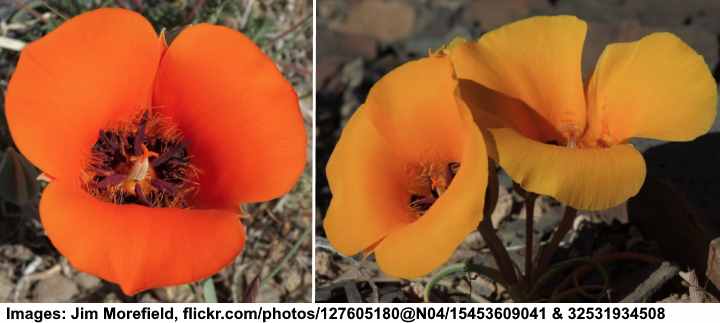
The attractive colorful flowers of the desert mariposa lily can be yellow, orange or red and grow on short stems
The desert mariposa lily is a perennial herbaceous desert plant with three-petalled red, yellow, or orange bell-shaped flowers. The showy desert flowers grow 2” (5 cm) long. The pointed silvery-green leaves measure 4” to 8” (10 – 20 cm) and grow on short, twisting stems up to 20” (50 cm) tall, but typically shorter.
Also called the flame mariposa and red mariposa lily, the desert mariposa lily is a bulbous desert plant that thrives in dry, rocky, well-drained soils. In an arid garden landscape, you can plant the mariposa lily in borders, rock gardens, and mixed beds — anywhere in soil with excellent drainage.
Flowering Desert Trees (With Picture and Name) – Identification Guide
Several types of desert trees thrive in harsh, arid environments. Many trees that grow in the desert also produce spectacular flowers. Here are four kinds of flowering desert trees for your landscape.
Desert Museum Palo Verde ( Cercidium x ‘Desert Museum’)
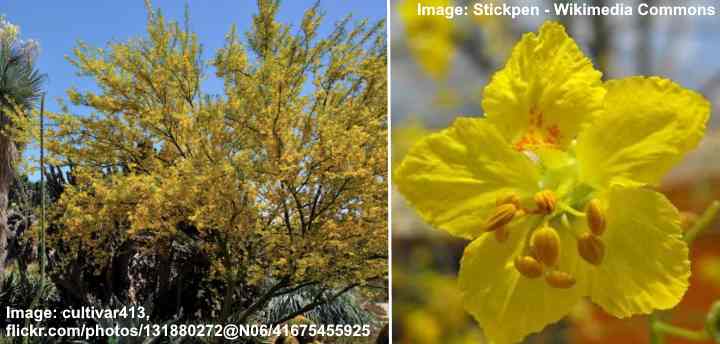
The yellow flowering Desert Museum palo verde tree grows in hot and dry conditions and requires full sun
The palo verde cultivar ‘Desert Museum’ is a fast-growing, small desert tree with an upright vase shape. Despite the hot, arid conditions, the flowering tree blooms in the desert. When in bloom, the tree has spectacular floral displays of large yellow flowers with ruffled petals that persist for several weeks.
Ornamental palo verde ‘Desert Museum’ desert trees are native to the Sonoran Desert. The tree grows up to 25 ft. (7.6 m) tall, and its bark has a characteristic rich green color throughout the year.
In an arid desert landscape, the ‘Desert Museum’ palo verde is ideal as an ornamental flowering tree . Plant the tree in full sun and keep it well-watered until its roots are established.
Chaste Tree ( Vitex agnus-castus )

The flowering chaste tree can grow in the arid and hot desert climate and include various cultivars with purple, pink or white flowers
The chaste tree is a heat-tolerant, drought-resistant flowering tree known for its conical purple bottlebrush blooms. The attractive multi-trunk ornamental tree thrives in several habitats, including dry landscapes. Apart from its spectacular lavender sprays, the tree is characterized by its sage-scented palmate leaves and upright habit with densely-growing foliage.
Chaste trees grow 3 to 16 ft. (1 – 5 m) tall, depending on how you prune them. The summer-blooming tree is ideal as a garden or patio tree, adding color and fragrance to a front or backyard. You can also train chaste trees to grow as a shrub border to accent the landscape or plant in a shrub border.
Mulga Tree ( Acacia aneura )
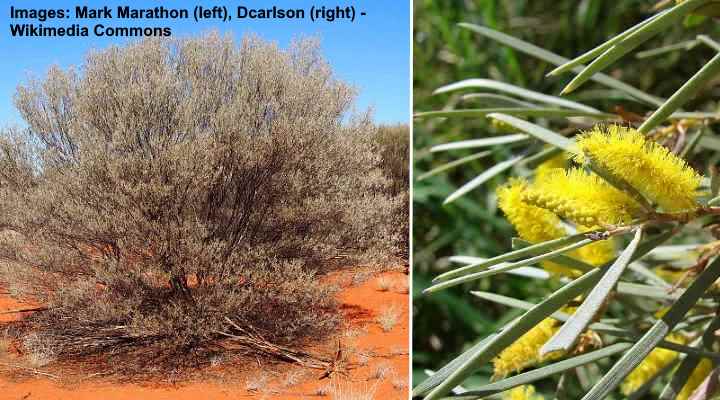
Mulga is a shrubby tree with yellow flowers that can be found in the hot and sunny desert climate
The mulga tree is a shrub-like small tree that thrives in desert landscapes . The slow-growing desert tree thrives in the hot sun and rocky soils and survives with occasional watering. The tree blooms with lemon-yellow caterpillar-shaped blooms that complement the silvery gray-green leaves. The tree typically blooms in the deserts after summer rainfall.
The mulga tree is an Australian native tree adapted to desert locations in the southwestern United States. The small desert trees are versatile drought-tolerant trees, ideal for xeric landscapes. Expect the tree to reach 20 ft. (6 m) tall eventually.
Anacacho Orchid Tree ( Bauhinia lunarioides )
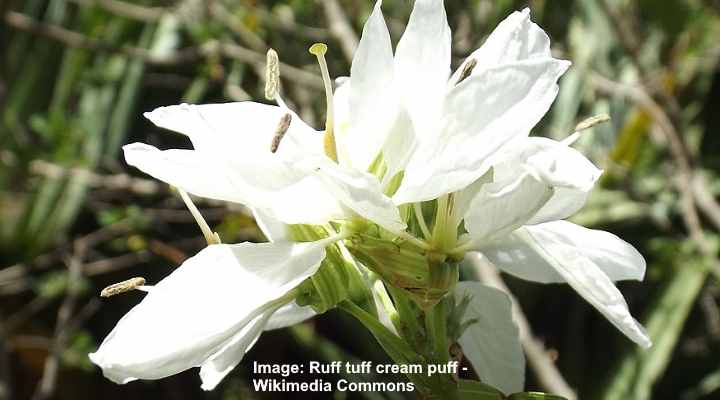
The white flowering Anacacho orchid is a small tree suitable for desert landscape
Also called the Texas plume, the Anacacho orchid tree is a small flowering tree with eye-catching white flowers. The desert-friendly tree is characterized by its light-green, bi-lobed leaves, orchid-like flowers, and flattened seed pods. In addition, the orchid tree has silvery-gray bark, giving the tree visual appeal when the leaves drop.
The small flowering desert tree grows up to 13 ft. (4 m) tall. The dwarf landscaping tree is useful as a specimen tree in arid landscapes or growing in a container. Its showy flowers and unique foliage make this a spectacular specimen plant.
Flowering Cactus in the Desert (With Picture and Name) – Identification Guide
Flowering cactus plants are the most recognizable of all the hardy plants that grow in the desert . Many species of cacti have flowers that bloom in red, pink, white, orange, and purple shades. And some cactus species bloom regularly, and some very occasionally.
Prickly Pear ( Opuntia )
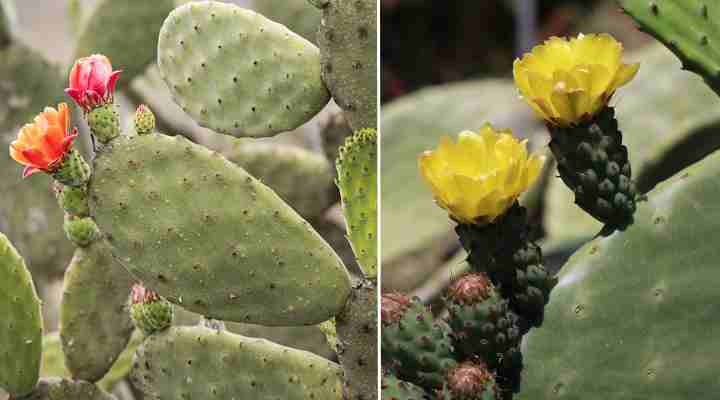
Prickly Pear (Opuntia)
Prickly pear is a species of flowering cactus common in many desert landscapes. Prickly pear cacti are identified by their oval paddle leaves covered in spiny thorns and tiny bristles. Many types of prickly pears bloom with showy, bowl-shaped pink, yellow, red, or orange flowers.
The large pad-like segments of a prickly pear flowering cactus are typically covered in spines. This is a multi-stemmed cactus with bluish-green pads 14” (36 cm) long and 10” (25 cm) wide. After the flowers bloom in the spring, juicy fruits called figs or tunas appear. These desert fruits are 2” to 3” (5 – 7.5 cm) long and taste like watermelon.
Cane Cholla ( Cylindropuntia imbricata )
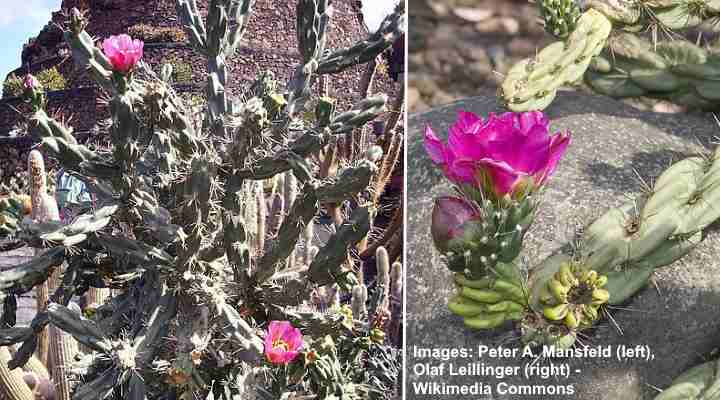
Cane cholla is a sun-loving desert cactus with pink-purple flowers
The cane cholla is a tree-like cactus desert plant with bright pink to purple cup-shaped flowers. These large, showy desert flowers measure 3” (7.5 cm) across. The spiny cactus plant is characterized by its rope-like gray-green stems. Its interesting sculptural shape gives the flowering cactus year-long visual appeal.
The cane cholla cactus grows 3 to 8 ft. (1 – 2.4 m) tall and is commonly found in hot deserts in Texas and the southwestern United States. After the purple-pink flowers bloom, bright golden yellow fruits appear on the spiky stems. The sun-loving cactus is perfect for desert gardens.
Claret Cup Cactus ( Echinocereus triglochidiatus )
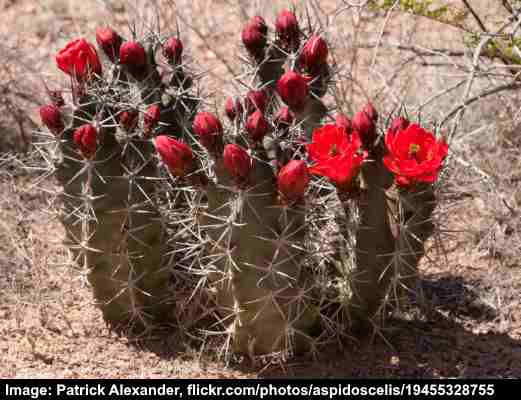
Claret cup is a red flowering cactus that is suitable for desert or rock gardens
Also called the kingcup cactus, this native southwestern flowering cactus has crimson red flowers blooming among spiny stems. The mound-forming cactus plant is identified by its fleshy cylindrical to spherical bluish-green upward-growing stems. These are covered in sharp spikes, and bright red flowers appear from spring until early summer.
Claret cup cacti grow 15” to 24” (37 – 60 cm) tall and create spiky mounds. You can grow the flowering cactus in desert gardens, Mediterranean gardens, and decorative containers. In addition to the bright red flowers, the cactus produces yellow-green, sometimes red, edible fruits.
Blooming Saguaro Cactus ( Carnegiea gigantea )
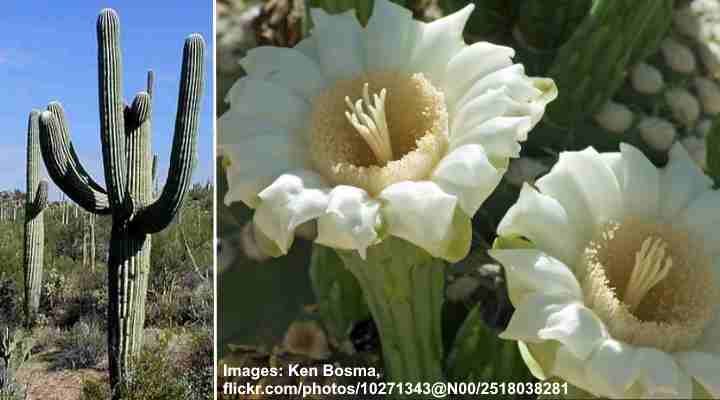
The saguaro cactus is common in desert landscape and has beautiful large white flowers
The flowering saguaro cactus, with its easily recognizable upward-pointing arms, is a classic plant symbolic of the desert landscape. Native to the Sonoran Desert, the saguaro cactus has white, waxy funnel-shaped flowers. These huge flowers grow 3” to 5” (7.5 – 13 cm) long and typically open after sunset. After flowering, ruby red edible fruits appear on the desert cactus .
The columnar flowering desert saguaro cactus grows 10 – 52 ft. (3 – 16 m) tall. However, these flowering cacti are slow-growing plants and may take at least ten years to grow just 1 ft. (0.3 m).
Related articles:
- Desert Plants – Identification Guide
- The Best Desert Trees – Identification Guide
- Types of Desert Grass – Identification Guide
38 Flowers That Grow in the Desert: Discover Remarkable Desert Blooms and Their Plant Groups
Table of Contents
Sharing is caring!
Deserts may not be the first place that comes to mind when thinking about beautiful flowers, but there are actually many fascinating and vibrant species that thrive in these arid environments. In this article, we will explore 38 different species of flowers that grow in the desert, showcasing the incredible variety and beauty that can be found in these seemingly inhospitable landscapes.
These desert flowers will be grouped under various plant categories to help you better understand their unique characteristics and natural habitats. The variety of plants and colors represented in this list is a testament to the amazing resilience and adaptability of nature. So, without further ado, let’s dive into the stunning world of desert flora.
Cacti Flowers
Desert landscapes are home to a diverse array of flowering plants, with cacti being one of the most well-known and vibrant examples. Within this unique family of plants, various species boast extraordinary flowers that brighten the harsh desert environment.
The Saguaro (Carnegiea gigantea) is a large, tree-like cactus native to the Sonoran Desert. As the largest cactus in the United States, it produces stunning white flowers in late spring that later give way to red fruits in summer. The flowers have a unique beauty, providing a sharp contrast to the protective spines that cover this iconic desert plant.
Barrel Cactus
Barrel cacti, native to the deserts of the southwestern United States and Mexico, are known for their cylindrical shape and impressive size, which can exceed 10 feet in height. These fascinating plants produce vibrant flowers that range in color from yellow to orange, and even deep red, adding a pop of color to the arid landscape.
Cholla cacti encompass a large variety of species with numerous flower colors such as pink, purple, yellow, and red. These visually striking plants bear cylindrical stems and sharp spines, creating an eye-catching mix of beauty and danger. Their flowers bloom from spring to early summer, further enriching the desert flora.
Prickly Pear
Prickly pear cacti are renowned for their flat, spiny stems, known as pads, and their vibrant flowers that bloom in an array of colors from yellow and orange to pink and red. These plants are not only beautiful but also useful, as both their pads and fruit are commonly used as culinary ingredients in various dishes.
Hedgehog Cactus
Hedgehog cacti, characterized by their clustering and densely-spined stems, produce bright and vivid flowers ranging from pink and purple to red and orange. These stunning blooms appear in spring and summer, offering a burst of color amidst the desert landscape. They may be found in various North American deserts.
Fishhook Cactus
Named for the hook-like shape of their spines, fishhook cacti also contribute to the diversity of flowering desert plants. They often produce striking pink, red, or purple flowers that bloom during the spring and early summer months. The unique appearance of their flowers and spines make these cacti a captivating sight in the desert environment.
Desert flowers are known for their adaptability and ability to thrive in harsh conditions. Among these, succulents are particularly fascinating and diverse, with numerous species found throughout the world’s deserts. Let’s dive into some of the most popular succulents that can be found in desert environments.
Agave plants, often associated with hot and arid regions, are characterized by their rosette-like arrangement of fleshy leaves. These plants are slow-growing but resilient, often surviving for decades without much water. Some of the most well-known agave species include the Queen Victoria agave and the century plant, which can take up to 30 years to bloom.
Aloe plants also feature a rosette arrangement of thick leaves, often used for their soothing, medicinal properties. One of the most recognizable species is the Aloe vera, which can be found in many arid regions worldwide. There are many more aloe species, all of which have adapted to thrive in dry desert environments and can be utilized for various purposes, ranging from skin care to interior decor.
Yuccas are an interesting group of succulents endemic to the Americas, characterized by their long, pointed leaves and tall flower stalks. One notable species is the Joshua Tree, found in the Mojave Desert, which can grow up to 40 feet tall. Other prevalent yucca species include the Spanish dagger and the soaptree yucca, named for the soap-like substance obtained from its roots.
Ice plants are a unique group of succulents that showcase a range of brightly colored flowers. With their petals available in pink, white, purple, or yellow, these plants can brighten up even the most barren desert landscapes. Notable species include the Starburst, Hardy White, Cooper’s Ice Plant, and Hardy Yellow.
Lithops, often referred to as “living stones,” are small succulents that mimic the appearance of pebbles. These plants blend seamlessly with their arid surroundings, making them an intriguing addition to the world of desert flora. Their unique, camouflage-like adaptation protects them from predators while allowing them to conserve water efficiently.
Living Stone
Similar to Lithops, living stone plants are part of the Aizoaceae family and are well-adapted to mimic their surroundings. These charming, low-maintenance plants are sought after by collectors and enthusiasts for their compact size, interesting appearance, and ability to withstand periods of drought. Popular varieties within this group include Pleiospilos and Conophytum.
Perennials are a popular choice for desert gardens because they are well adapted to the harsh climatic conditions and provide color and texture throughout the year. Here, we will be discussing some exceptional desert perennials that will give your garden a vibrant touch.
Desert Marigold
Desert Marigold (Baileya multiradiata) is a golden yellow flower that grows in the dry soil of desert regions. It thrives under full sun and has low water requirements, making it ideal for the arid climate. Its bright yellow flowers can bloom from spring to fall, adding a stunning burst of color to any desert garden.
Mojave Aster
Mojave Aster (Xylorhiza tortifolia) is a resilient perennial boasting lovely lavender flowers with yellow centers. It blooms mainly in the spring, attracting bees and butterflies to the garden. This plant prefers well-draining soil and full sun exposure, making it a perfect addition to a desert landscape.
Penstemon is a group of desert perennials known for their tubular-shaped flowers in various colors, including red, pink, blue, and purple. They grow well in dry soil and under full sun or partial shade. Common species such as the firecracker penstemon (Penstemon eatonii) and pine-leaf penstemon (Penstemon pinifolius), create a mesmerizing display when planted together.
Blackfoot Daisy
Blackfoot Daisy (Melampodium leucanthum) is a low-maintenance perennial that blooms from spring to fall. It features white flowers with yellow centers, resembling small daisies. This plant requires minimal water and thrives in sunny locations with well-draining soil, making it an excellent choice for a desert garden.
Globe Mallow
Globe Mallow (Sphaeralcea ambigua) showcases apricot to orange flowers and is a favorite among desert gardeners. This drought-tolerant perennial prefers full sun and dry soil. Its velvety foliage adds a unique texture to the garden, while the colorful flowers can attract hummingbirds and butterflies.
Ocotillo (Fouquieria splendens), although not a typical perennial, is a remarkable desert plant with its tall, spiny stems and vibrant red flowers. It can grow in full sun or partial shade and withstands the arid desert conditions with ease. This distinctive plant is known for attracting hummingbirds and adds an architectural flair to any desert landscape.
Each of these desert perennials offers unique beauty and resilience, making them ideal candidates for adding color, texture, and life to your desert garden.
Desert landscapes are home to several beautiful annual flowers that have adapted to thrive in the harsh, arid conditions. This section highlights six of these resilient species, which add bursts of color to the seemingly barren environment.
Desert Sunflower
The Desert Sunflower, or Geraea canescens, is a vibrant, yellow bloom that brings life to desert sands. With slender stalks and rough leaves, these flowers grow up to 3-feet tall and can be found scattered throughout lower elevations in arid areas. They are drought-resistant and can bloom from February to May, attracting pollinators like butterflies and bees.
Sand Verbena
Characterized by its clusters of fragrant, pink to purple flowers, the Sand Verbena (Abronia villosa) can be spotted in desert dunes and sandy areas. Adaptable to low-water conditions, they typically bloom from mid-winter to late spring, attracting bees and other pollinators.
Dune Evening Primrose
The Dune Evening Primrose (Oenothera deltoides) is a desert annual known for its large, white flowers. The petals open in the evening and close by midday, making it a fascinating sight in the desert. These flowers tend to bloom from February to June and are often found in sandy or rocky habitats.
Desert Poppy
With bright orange, delicate petals surrounding a dark center, the Desert Poppy (Eschscholzia glyptosperma) is an iconic desert flower. Growing in sandy washes and gravelly slopes, they typically bloom from February to May, providing a vibrant contrast to their harsh surroundings.
Desert Lupine
The Desert Lupine (Boja filipes) is a stunning annual that features tall spikes of blue to purple flowers. They are common in desert washes and slopes, blooming between February and April. These hardy flowers are not only drought-resistant but can also withstand freezing temperatures.
Woolly Daisy
The Woolly Daisy (Eriophyllum lanatum) is a low-growing, mounding annual that is covered in small, bright yellow flowers. They are typically found in rocky or gravelly desert areas, blooming from March to June. The woolly hairs on the stems and leaves of these daisy-like flowers help them survive in the dry conditions of the desert.
These six desert annuals demonstrate the resilience and beauty of nature, even in the harshest conditions. By understanding their unique qualities and adaptations, we can appreciate and marvel at the diversity of flora found in desert environments.
Desert shrubs provide an essential source of shelter and sustenance for many desert-dwelling organisms. These hardy plants have adapted to the harsh conditions of arid environments, boasting unique features that enable them to thrive in such challenging habitats. Let’s explore some striking examples of desert shrubs:
Creosote Bush
Thriving in the hot deserts of North America, the Creosote Bush (Larrea tridentata) is an evergreen shrub characterized by its small, waxy leaves and yellow flowers. Its resilience to drought conditions is thanks to its extensive root systems, which absorb and conserve water effectively.
Brittlebush
Encelia farinosa, commonly known as Brittlebush, is native to the southwestern United States and Mexico. This gray-leaved shrub produces bright yellow flowers that attract pollinators. To cope with water scarcity, Brittlebush has small, hairy leaves that reduce water loss through evaporation.
Named for their seed-bearing burrs, Bursage (Ambrosia spp.) is a genus of shrubs prevalent in desert habitats across North America. With their grey-green leaves and modest flowers, these plants are a crucial food source for herbivores in the ecosystem. Drought-tolerant, the Bursage stores water in its thick, fleshy stems.
Smoke Trees (Psorothamnus spinosus) are native to the deserts of California and Arizona. They derive their name from the wispy, smoke-like appearance of their bluish-gray branches when in full bloom. Adapted to arid conditions, Smoke Trees have deep taproots that seek out hidden water sources.
Four-Winged Saltbush
Four-Winged Saltbush (Atriplex canescens) is a hardy desert shrub found across the western United States. Recognized by its small, silvery leaves and winged seed capsules, this plant is well-suited to saline soils, often thriving where other plants struggle to grow.
Chinese Lantern Plant
The Chinese Lantern Plant (Abutilon spp.) originates from the arid regions of Central and South America. Known for its bell-shaped flowers and lantern-like seed pods, this desert shrub has adapted to store water in its stems and leaves, enabling it to endure long periods of drought.
In conclusion, desert shrubs exemplify nature’s resilience and adaptability to extreme environments. With their unique characteristics and vital roles in the ecosystem, these plants offer a stunning glimpse into the world of desert flora.
Desert Flowers
The creosote bush is native to desert regions and is the state flower of Arizona. It has evolved several adaptations to help it survive in low-water environments, such as a deep root system.
Yucca plants are prevalent in desert areas. They have long, sharp leaves that help them capture moisture from the air, along with a deep root system for better access to underground water sources.
Aquatic Plants
Some plants have evolved to live and thrive in water, creating unique aquatic ecosystems. In this section, we will discuss a few examples of such plants, such as the Yellow Water Lily, Pondweed, Parrot’s Feather, Tule, Arrowhead, and Cattail.
Yellow Water Lily
Yellow Water Lilies are beautiful aquatic plants with large, round green leaves that float atop the water’s surface. Their vibrant yellow flowers grow on long stems, creating a distinctive appearance in ponds and other shallow water bodies.
Pondweed typically grows in shallow, slow-moving water. It has narrow, submerged leaves that help it to take up nutrients and oxygen from the water. Pondweed provides a crucial habitat for various aquatic organisms, contributing to a healthy ecosystem.
Parrot’s Feather
Parrot’s Feather is a versatile aquatic plant that can grow both submerged and on the water surface as long, trailing stems. Its feathery, bright green leaves can add texture and depth to water gardens and ponds. This plant provides shelter for fish and other aquatic life.
Tules are tall, grass-like plants that grow in wetlands and along the shores of water bodies. They have an iconic appearance, with clusters of thin, reed-like stems crowned with brown flowers. Tules provide habitat for wildlife and help to filter and purify water.
Named for their distinctively shaped leaves, Arrowheads are eye-catching aquatic plants that grow in marshy areas and along the edges of ponds. They produce attractive white flowers, adding a touch of elegance to any aquatic environment.
Cattails are a familiar sight in wetlands, ponds, and marshes. They have tall, slender stems topped with brown, sausage-like flowers. These plants serve a vital role in providing habitat for wildlife and improving water quality by removing excess nutrients.
My name is Daniel Elrod, and I have been houseplant love ever since I was 17. I love how much joy they bring to any room in the home. I’ve always been amazed at how a few pots of flowing leaves can turn a drab and sterile office into an inviting place where people love to work at.

COMMENTS
Desert Flower: The Extraordinary Journey of a Desert Nomad is a memoir published in 1998 by the Somali model, author, and activist Waris Dirie and author Cathleen Miller. The book recounts Dirie's harrowing life story, from her roots as a member of a nomadic family and the abuses she suffered as a child to her rise to international fame as a fashion model, an ambassador and advocate for ...
April 27, 2022. Desert Flower: The Extraordinary Journey of a Desert Nomad, Waris Dirie. Waris Dirie escaped from her native Galkayo, Somalia, fleeing to Mogadishu to escape an arranged marriage. Moving with relatives to London, she worked for a while at a McDonald's and was discovered by chance by fashion photographer Terence Donovan.
Desert Flower. Desert Flower: The Extraordinary Journey of a Desert Nomad is Waris Dirie 's memoir. A Somali model and human rights activist, in this book Dirie anecdotes her life journey - a journey filled with obstacles and her never say die spirit. The writing is raw and unpolished, mirroring the author's frame of mind and emotions.
Desert Flower. Desert Flower: The Extraordinary Journey of a Desert Nomad is an autobiographical book written by Waris Dirie and Cathleen Miller, [1] published in 1998 about the life of Somali model, Waris Dirie.
Get unlimited access to SuperSummaryfor only $0.70/week. Thanks for exploring this SuperSummary Study Guide of "Desert Flower" by Waris Dirie. A modern alternative to SparkNotes and CliffsNotes, SuperSummary offers high-quality Study Guides with detailed chapter summaries and analysis of major themes, characters, and more.
Introduction. Desert Flower is the true Story based on the life of Waris Dirie. All actions, mentioned in the text are factual. The author of the book, "Desert Flower", Waris Dirie, is a very hardworking girl. She is one of the children born into a traditional family of tribal desert nomads of Somalia in East Africa.
At the age of thirteen, Waris' father sells her to an old man for five camels. Before the wedding, Waris decides to escape from her tribe. She runs in the desert for many days and finally finds ...
Chapter 1 Summary: "Running Away". Content Warning: This section of the guide contains descriptions of female genital mutilation, rape, and attempted rape. The novel opens in Somalia. Waris Dirie, a 13-year-old girl, wakes up from a nap under a tree. A lion is standing over her, and Dirie is sure that she is about to die.
Through our Desert Flower Centers we try to help and guide victims of FGM to regain, as much as possible, their life quality and confidence. The books. Desert Flower. In 1997 Harper Collins in New York published Waris Dirie's biography "Desert Flower" and the book quickly became an international bestseller. Since then, the book has been ...
Waris Dirie (the name means desert flower) lives a double life - by day she is a famous model and UN spokeswoman on women's rights in Africa, at night she dreams of her native Somalia. Waris, one of 12 children, was born into a traditional family of desert nomads in East Africa. She remembers her early childhood as carefree- racing camels and ...
Role In: women's rights movement. Waris Dirie (born 1965, Galcaio, Somalia) is a Somalian fashion model, author, and women's rights activist known for her efforts to eliminate female genital mutilation (FGM), also called female circumcision. Dirie was one of 12 children born into a large nomadic family living near Somalia's border with ...
Desert Flower is the inspiring life story of Waris Dirie's transformation from Somali desert nomad to international supermodel. The story begins with Waris' pastoralist childhood in the Somali desert, where she lives with her family. During this time, she is voluntarily circumcised, an event which greatly impacts the rest of her life.
2. Desert Flower "Desert Flower" is the memoir of Waris Dirie. It is the story of how a nomadic girl from a backward country, Somalia, rises to become an internationally known super-model and then takes the top assignment as the UN Ambassador for the cause of women. She is a remarkable beauty with extraordinary courage.
This thesis is submitted to the Central Department of English, Tribhuvan University by Mr. Raju Kunwar entitled "Politics of Memory in Waris Diri's Desert Flower" has been approved by the undersigned members of the thesis Research Committee. Members of the Research Committee: _____ _____ Internal Examiner
Desert Flower: Waris Dirie Analysis. Waris Dirie was born into a family of nomads in a Somalian desert. Growing up, she was privileged to run free with nature's most majestic animals, and learned a respect for nature that many of us as Americans could never fathom. However, these thrills are just on the surface of what life is really like for ...
He eventually steals her money and flees the country. Mr. O'Sullivan - An old Irish man who Mr. Wheeler suggests that Waris marry in order for her to get a passport. He is an old drunk and he also takes Waris' money. Nigel - The brother of one of Waris' model friends who helps Waris out and eventually marries her so she can have a passport.
Pick one of the tasks and write a longer text. Make sure you give references and list sources you have used. Write an analysis of the film Desert Flower.; Write a discussion text where you consider if respecting other cultures means that traditions such as child marriage and female genital mutilation must be accepted.
Now streaming on: Powered by JustWatch. "Desert Flower" tells an extraordinary story in an ordinary way. It has a compelling message and surrounds it with biopic scenes that appear to be brought in from a different kind of movie. The effect is rather unsettling. The film is based on the life of Waris Dirie, an international supermodel who began ...
The desert mariposa lily is a perennial herbaceous desert plant with three-petalled red, yellow, or orange bell-shaped flowers. The showy desert flowers grow 2" (5 cm) long. The pointed silvery-green leaves measure 4" to 8" (10 - 20 cm) and grow on short, twisting stems up to 20" (50 cm) tall, but typically shorter.
An Analysis of Feminism——A Case Study of Desert Flower. 李传益, 王薇. Published 2012. Sociology. With the development of globalization,people have paid more and more attention to feminism.But under the influence of traditional androcentric society for thousands of years,it' s hard for women to strive for equal rights with men and to ...
California Poppy. The California Poppy (Eschscholtzia californica) became California's official state flower on March 2, 1903. The four-petal desert flowers, borne on stems 8 to 12 inches (20 to 30 cm) long, are typically cream, orange, or pale yellow. Still, cultivars are white and in a variety of pinks and reds.
The petals open in the evening and close by midday, making it a fascinating sight in the desert. These flowers tend to bloom from February to June and are often found in sandy or rocky habitats. Desert Poppy. With bright orange, delicate petals surrounding a dark center, the Desert Poppy (Eschscholzia glyptosperma) is an iconic desert flower.